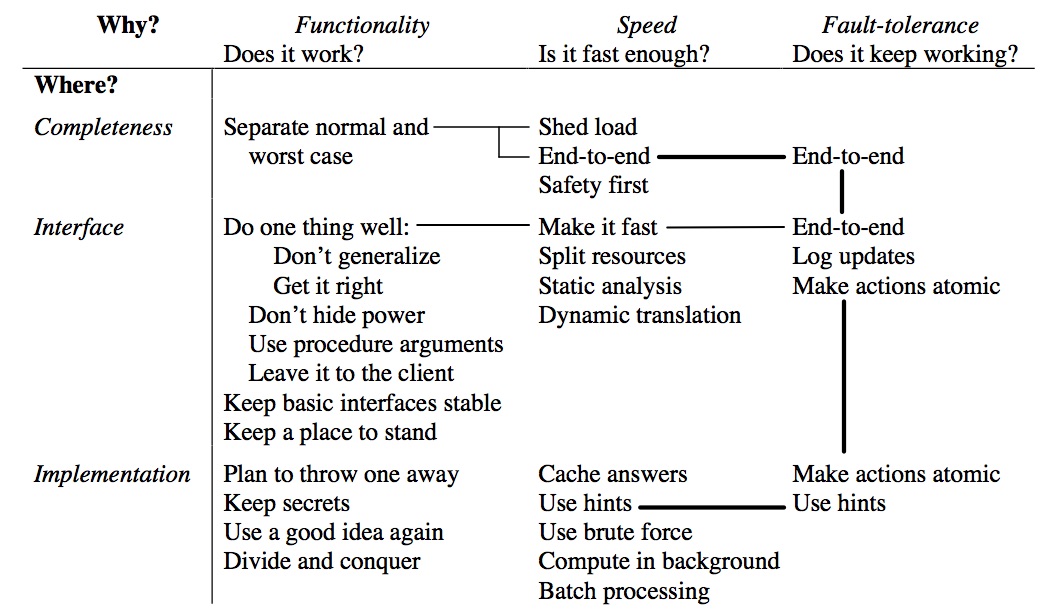Technical Women
An Analysis of Linux Scalability to Many Cores
-
Silas Boyd-Wickizer
-
Austin T. Clemens
-
Yandong Mao
-
Aleksey Pesterev
-
M. Frans Kaashoek
-
Robert Morris
-
Nickolai Zeldovich
$ cat announce.txt
-
Course evaluation is currently… 45%.
-
Please do the evaluation! Time is running out…
Discussion of the Hints

Paper Overview
-
Benchmarking and analysis paper. (A kind we did not previously discuss…)
-
But also kind of a big idea paper.
-
People (including the authors) have been proposing that traditional OS designs would not scale to many-core machines.
-
Is this true?
There is a sense in the community that traditional kernel designs won’t scale well on multicore processors: that applications will spend an increasing fraction of their time in the kernel as the number of cores increases. Prominent researchers have advocated rethinking operating systems and new kernel designs intended to allow scalability have been proposed (e.g., Barrelfish, Corey, and fos). This paper asks whether traditional kernel designs can be used and implemented in a way that allows applications to scale.
This question is difficult to answer conclusively, but we attempt to shed a small amount of light on it.
What’s The Approach?
-
Benchmark Linux using applications that should scale well.
-
Identify and fix scalability bottlenecks.
-
Repeat.
First we measure scalability of the MOSBENCH applications on a recent Linux kernel (2.6.35-rc5, released July 12, 2010) with 48 cores, using the in-memory tmpfs file system to avoid disk bottlenecks. gmake scales well, but the other applications scale poorly, performing much less work per core with 48 cores than with one core.
We attempt to understand and fix the scalability problems, by modifying either the applications or the Linux kernel.
We then iterate, since fixing one scalability problem usually exposes further ones.
The end result for each application is either good scalability on 48 cores, or attribution of non-scalability to a hard-to-fix problem with the application, the Linux kernel, or the underlying hardware.
The analysis of whether the kernel design is compatible with scaling rests on the extent to which our changes to the Linux kernel turn out to be modest, and the extent to which hard-to-fix problems with the Linux kernel ultimately limit application scalability.
What’s The Result?
Our final contribution is an analysis using MOSBENCH that suggests that there is no immediate scalability reason to give up on traditional kernel designs.
What is MOSBENCH?
-
A mail server (
exim), using multiple processes to process incoming mail concurrently. -
An in-memory key-value store object cache (
memcached), using multiple servers to handle multiple connections in parallel. (Already working around an internal bottleneck.) -
A web server (
apache) using one process per core. -
A database server (
postgres), which starts one process per connection. -
A parallel build (
gmake) building Linux using multiple cores. -
A file indexer (`psearchy').
-
A map-reduce library (
metis).
-
The goal is to identify kernel bottlenecks.
-
Spending more time in the kernel as the number of cores rises.
(Aside) Why Does gmake Scale Well?
All the benchmarks scale poorly to multiple cores…except gmake.
-
Because kernel developers use it all the time!
gmakeis the unofficial default benchmark in the Linux community since all developers use it to build the Linux kernel. Indeed, many Linux patches include comments like "This speeds up compiling the kernel."
The Problems
Here are a few types of serializing interactions that the MOSBENCH applications encountered. These are all classic considerations in parallel programming…
1) The tasks may lock a shared data structure, so that increasing the number of cores increases the lock wait time.
2) The tasks may write a shared memory location, so that increasing the number of cores increases the time spent waiting for the cache coherence protocol to fetch the cache line in exclusive mode. This problem can occur even in lock-free shared data structures.
The tasks may compete for space in a limited-size shared hardware cache, so that increasing the number of cores increases the cache miss rate. This problem can occur even if tasks never share memory.
The tasks may compete for other shared hardware resources such as inter-core interconnect or DRAM interfaces, so that additional cores spend their time waiting for those resources rather than computing.
There may be too few tasks to keep all cores busy, so that increasing the number of cores leads to more idle cores.
To The Paper
Next Time
-
Bonus class!
